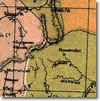
Pastoral Station entry
| Home | Browse | Search | Previous | Next |

|
Unlocking Regional Memory
Pastoral Station entry
|
|
Invermein Station |
|
|
|
| Location: Scone, New South Wales | |
Invermein Station, near the present-day town of Scone in the Hunter River region of New South Wales, was first taken up by Francis Little in 1825. Little was the nephew of Dr William Bell Carlyle, the surgeon in charge of transports, whose own success in the colony had made him enthusiastic about its future prospects. In the early-1820s, Carlyle persuaded Francis Little to apply for a land grant in New South Wales. He did so and in 1823 received a property of 2,000 acres in the Hunter Valley. The estate, which he named Invermein for the stream that flowed by his father’s house in Scotland, was occupied by Francis Little in June 1825. There he built a homestead and continued to purchase nearby land, including Carlyle’s Hunter Valley property, Satur, in 1844. Though a quiet, uncontroversial and highly-resepcted citizen, Little shares with Carlyle the unfortunate distinction of having introduced one of the worst pests to ravage eastern Australia. On one of his visits to Satur, in about 1833, Carlyle brought the leaf of a cactus plant from India which he felt would thrive in Mrs Little’s garden at Invermein. With infinite care Mrs Little propogated this exotic plant, known commonly as the prickly pear, but its extraordinary growth was soon the bane of pastoralists across the region. It was not until 1925 that some success was achieved in eradicating the dreadful plant. When Francis Little died in 1860, his eldest son, William, inherited Invermein Station. William Little retired in 1877, selling the estate to the brothers Frederick and Edward Parbury. Four years later, the property was subdivided after Edward Parbury’s death. The homestead and 2,000 acres of land were purchased by James Doyle, a member of an old colonial family with branches throughout the Hunter Valley and with interests extending far into Queensland. For more than a hundred years, Invermein (or Invermien, as the Doyles increasingly referred to it) remained the home of the Doyle family, but in 1994, when Geoff and Beryl White purchased nearby Bhima Stud (developed as a horse property by Vivian Bath in the second half of the twentieth century) they also acquired the historic property of Invermien. The Whites rejuvenated and merged the two properties into the professionally run broadmare farm of today. In 2002, the combined property was renamed Invermien to reflect the convergence of history and innovation. '[Invermien] has history and meaning', explained the Whites, 'and the fact that it has not run thoroughbreds before gives the White Family an opportunity to create their own history in the thoroughbred industry under the new identity'. Full Note:
|
|
|
| ||
|
Published by The Australian Science and Technology Heritage Centre, 5 April 2004 Prepared by: Acknowledgements Updated: 23 February 2010 http://www.nswera.net.au/biogs/UNE0225b.htm |